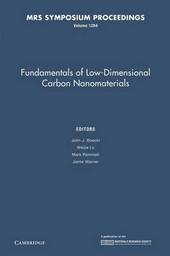
|
Fundamentals of Low-Dimensional Carbon Nanomaterials: Volume 1284
Paperback / softback
Main Details
| Title |
Fundamentals of Low-Dimensional Carbon Nanomaterials: Volume 1284
|
| Authors and Contributors |
Edited by John J. Boeckl
|
|
Edited by Mark Rummeli
|
|
Edited by Weijie Lu
|
|
Edited by Jamie Warner
|
| Series | MRS Proceedings |
|---|
| Physical Properties |
| Format:Paperback / softback | | Pages:202 | | Dimensions(mm): Height 229,Width 152 |
|
| Category/Genre | Materials science |
|---|
| ISBN/Barcode |
9781107406667
|
| Classifications | Dewey:620.115 |
|---|
| Audience | | Postgraduate, Research & Scholarly | | Professional & Vocational | |
|---|
| Illustrations |
9 Tables, unspecified; 33 Halftones, unspecified; 75 Line drawings, unspecified
|
|
Publishing Details |
| Publisher |
Cambridge University Press
|
| Imprint |
Cambridge University Press
|
| Publication Date |
5 June 2014 |
| Publication Country |
United Kingdom
|
Description
Symposium C, 'Fundamentals of Low-Dimensional Carbon Nanomaterials', was held November 29-December 3 at the 2010 MRS Fall Meeting in Boston, Massachusetts. This resultant proceedings volume includes topics such as growth techniques for CNTs and graphene, structural characterization, novel properties, and interface and surface structures. Low-dimensional carbon nanostructures exhibit a rich structural diversity from zero-dimensional C60, one-dimensional carbon nanotubes (CNTs), and two-dimensional graphene and graphite oxides. These low-dimensional carbon nanostructures are at the forefront of materials science and provide a platform for understanding the growth mechanisms and properties of nanostructures in general. They exhibit novel properties with endless potential applications from high-speed electronics to high-performance composites. Although low-dimensional carbon nanomaterials have attracted great interest in the research community, the applications and commercialization of graphene and CNTs have, to date, not been as successful as anticipated. The need for significant improvements in material quality and structural uniformity exists.
|